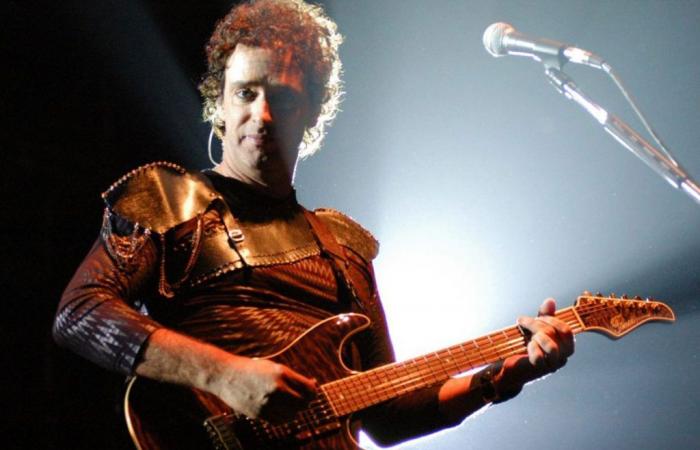It is a tour of 15 songs that marked the beginning of a solo cycle, which continued with three other studio albums, but which above all represented the clearest example of the talent and sonic curiosity of the musician who led Soda Stereo. His true solo career was beginning (Yellow love1993, worked as a mini-vacation) with a gesture of audacity typical of his talent. Everything in that album, which on the cover had Gustavo Cerati blowing smoke against the light, was a treat of melodies and textures that still keep it in full force, exactly 25 years after its release, for being ahead of its time.
Puff It came out on June 28, 1999 and was the result of an experiment that was born in his home in Vicente López, in a studio set up with the aim of experimenting almost as if he were in a laboratory, after leaving his successful band for years. Cerati was increasingly interested in using technology as a trigger for his creativity, so he had collected a bank of samplers and sketches that ended up marking that musical path that he would never completely abandon.
Two of the “Bocanada” songs were immediate hits: the lilting “Puente” and its thanks for coming (direct hyperlink with total thanks pronounced in River two years before, the first nostalgic nod to the band that had just been left behind) and The zigzagging elegance of “Paseo immoral” was liked as soon as it was released. The record company chose “Raíz” as the first cut to be released, but there were also great songs like “Tabú”, “Engaña”, the hypnotic ballad that gives its name to the album or the danceable song titled “Río Babel”. There was also “Verbo carne”, a masterpiece in ballad mode that featured symphonic arrangements recorded in none other than Abbey Road by the London Session Orchestra.
After watching the session, in which violinist Gavin Wright conducted 48 musicians, Cerati “ran with the tapes” to another studio in London. There he gave voice to her in a state of total ecstasy, he would say in several interviews. It was for him the pinnacle of that album that marked a generation.
Cerati’s word
After the release, in an interview by Alfredo Rosso for Rolling Stone, Cerati said that for him to make Puff It was like filming a movie. “Not because there is an argument, the album does not talk about a single thing, it is rather eclectic, but because we manage the moods, the climates in a filmic way,” commented the former Soda. Cerati was not interested in making a conceptual album, but rather trying different forms, connecting current sounds with old influences. He simply set out to make the best music he could, with total freedom.
Almost 40 years old (he would have turned in August of that year) he put together his band and launched himself. Flavio Etcheto was the first to be summoned, later adding bassist Fernando Nalé and drummer Martín Carrizo. Leo García also arrived, who contributed his own, as did journalist Pablo Schanton, who helped him with some lyrics. “Participating in the album ‘Bocanada’ I think had to do more than anything with getting to know Gustavo more deeply, because it was when he really began his career as a soloist after the separation of Soda Stereo. It was seeing Gustavo starting, starting his career again,” says Leo García.
“What Gustavo asked for was friendship, at that time. And that was what we gave him. I think the first musician who started out by his side was Flavio, then me, in fact we did a show in Recoleta together. We did songs by yellow love and of holy colors. There was already a gang attempt. Before entering the studio for Gustavo to show us the projects he was doing, on the one hand he did it separately, he got together with Flavio and then he got together with me, we had been seeing each other very often, we listened to new music. There was a musical trend that we really liked, that also inspired a lot.”
For Leo García, “Bocanada” is without a doubt pure avant-garde. Avant-garde is always understood 20 years later, and in this case 25 years have already passed, “so you listen to it and it is a completely current album and it will always be like that. It is a timeless album, it is a mega work and I think it is excellently correct. It coexists with the here and now.”
Francisco Bochatón also collaborated: “He had produced some songs for a solo album I was making and he gave me tracks to put music to. It was an honor. I didn’t realize it at the time, but it was something done with pure freedom. We did ‘Paseo inmoral’ together and we also worked on some of ‘Tabú’. He showed us electronic experiments with guitars that were great. He made great songs. It was incredible to see him work, because of how creative and enjoyable it was,” recalls the leader of Peligrosos Gorriones, who considers that album to be “more of a band than a soloist, but Gustavo had a very personal style. It is a high-level work, it competes with any historical album from abroad, and he managed to make music that represents many of us. It is an album with many influences from all sides and it is a timeless album, it is a sign that you can make art and survive the consumerism of fashion.” He also states that “these songs were a sample of his talent and what was going on in his head. I am certain that he inspired many.” It’s a flash, it’s a mark that will remain forever because it shows that if you believe, you can do it: his style was positive, his way of playing and composing was real but brilliant. It’s something we miss but that is always with us because it’s in his songs.”



